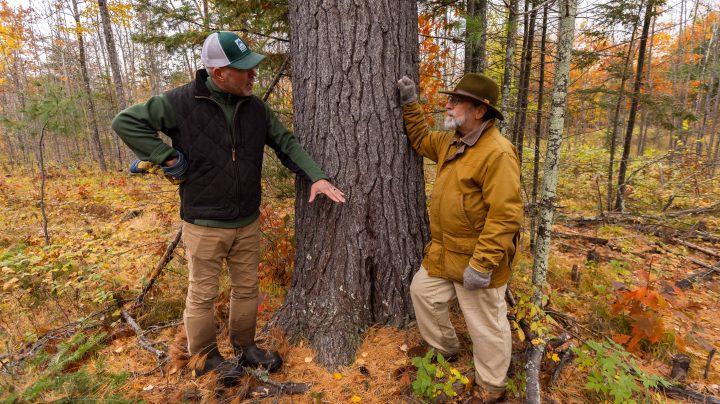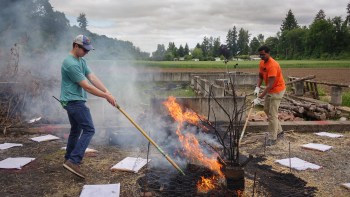
A Minnesota company says its ecological logging approach is good for the forest — and the bottom line
A Minnesota company says its ecological logging approach is good for the forest — and the bottom line

John Rajala hiked into a 6,000-acre tract of land he calls Wolf Lake Camp that his family bought over 50 years ago.
“This is hallowed ground that we’re about to walk into now,” he said on that fall day.
He’s a fourth-generation logger, an Ivy League grad who says he’s as much a tree hugger as he is a tree cutter.
A hawk soared overhead among old-growth pines. More than 20 other species of trees — from yellow birch to red oak — surround clear lakes. It seems like a protected park, but there are signs that this is a working forest.
“There’s a two-year-old stump, there’s a 15-year-old stump,” he pointed out. Then he stopped in front of a giant white pine tree. He estimates it’s about 120 years old.
“It is of immense quality, because it is nearly 24 feet to the first limb. And that’s music to a logger and a sawmiller’s ears and eyes,” Rajala said, because it could be made into long, straight, valuable timbers.
But “I don’t know that we’ll ever cut this tree down,” he added.
Rajala’s company practices a more ecological approach to forestry than clearcutting. He leaves behind many of the most valuable trees for the health of the forest and to provide seeds for future big trees.
It’s a different approach for the forests around the Great Lakes, where logging often meant clearcutting, and then letting the woods grow back with fast-growing trees.
“We’re in the lumber business. We’re in the millwork business. We need these trees for our mill, but we need them for a seed source more,” Rajala said. “So we just have to be patient.”
But it can be hard to be patient on the timescale of a tree.
“Profits have to be deferred for when you cut the big trees. And that could be 80 years down the line,” said John Pastor, a retired forest ecologist at the University of Minnesota Duluth, who’s written a new book on the white pine.
But there is eventually a payoff, Pastor said, for those who spend the time actively managing the forest and delaying their harvest.
“Then, when you cut that tree, it’s going to be a really valuable tree,” he said. “So that’s the trade-off.”
On a nearby plot of land on the Chippewa National Forest, U.S. Forest Service ecologist Brian Palik said more landowners are interested in this kind of forestry — one that manages for a diversity of tree species and ages, and tries to mimic nature by cutting down select trees to imitate a fire or a windstorm.
But it’s not a widespread approach.
“Because to be able to do this takes resources,” Palik said. “And you have to be able to sell timber in some form or fashion to be able to pay for the kind of management that we’re looking at here.”
John Rajala said he pays for that forest management by selling high-quality products at a premium price.
In a big metal building nearby in the tiny town of Deer River, Minnesota, workers transform freshly cut trees from the forest Rajala hiked earlier into wood paneling and other custom products.
“That is some really special stuff,” he said as he held up a long plank of six-inch-wide paper birch flooring. He said this sells for $6 a square foot. That’s more expensive than at a big box store.
But he said, he’s confident there’s a market for it.
“Minnesotans care about their forests. And if we can tap into their desire to play a role in that, well, this is a win-win,” he said. “And a huge amount of the money that is generated from this revenue is going back into the forest.”
Rajala estimates 50% of his profits are used to manage the forest to grow and sustain future generations of trees.
There’s a lot happening in the world. Through it all, Marketplace is here for you.
You rely on Marketplace to break down the world’s events and tell you how it affects you in a fact-based, approachable way. We rely on your financial support to keep making that possible.
Your donation today powers the independent journalism that you rely on. For just $5/month, you can help sustain Marketplace so we can keep reporting on the things that matter to you.

















